SMITH, CHARLES JOHN (1803–1838), engraver, was born in 1803 at Chelsea, where his father, James Smith, practised as a surgeon. He was a pupil of Charles Pye [q. v.], and became a good engraver of book illustrations of a topographical and antiquarian character. He executed a few of the later plates in Charles Stothard's ‘Monumental Effigies,’ the views of houses and monuments in E. Cartwright's ‘Rape of Bramber,’ 1830, and several of the plates from illuminated manuscripts for Dibdin's ‘Tour in the Northern Counties of England,’ 1838. In 1829 Smith published a series of ‘Autographs of Royal, Noble, and Illustrious Persons,’ with memoirs by John Gough Nichols [q. v.], and later undertook another serial work, ‘Historical and Literary Curiosities,’ which he did not live to complete. He was elected a fellow of the Society of Antiquaries in 1837, and died of paralysis in Albany Street, London, on 23 Nov. 1838.
[Gent. Mag. 1839, i. 101; Redgrave's Dict. of Artists.]
SMITH, CHARLES ROACH (1807–1890), antiquary, born at Landguard Manorhouse, near Shanklin, Isle of Wight, on 20 Aug. 1807, was the youngest child of ten children of John Smith, a farmer, who married Ann, daughter of Henry Roach of Arreton Manor in the same island. The father died when the child was very young, and his maternal grandfather's house at Arreton became his second home. The mother died about 1824. The lad went to the school of a Mr. Crouch at Swathling, and when the master migrated to St. Cross, near Winchester, Charles followed him. About 1820 he went to the larger establishment of Mr. Withers at Lymington.
In 1821 Smith was placed in the office of Francis Worsley, a solicitor at Newport, Isle of Wight, but soon tired of this occupation. The army was then suggested for him, but in February 1822 he was apprenticed to a Mr. Follett, a chemist at Chichester. After remaining there for about six years he went to the firm of Wilson, Ashmore, & Co., chemists at Snow Hill, London, and then set up for himself at the corner of Founders' Court, Lothbury. His premises were taken over by the city at a great loss to him, and he removed to 5 Liverpool Street, Finsbury Circus, where he dwelt from 1840 to 1855. The business had now dwindled, and he purchased, as a place of retirement, the small property of Temple Place, Strood, near Rochester. In 1864 he was involved in an action at law with the dean and chapter of Rochester over some reclaimed land adjoining his property, and won the case.
At a very early date in his life Smith felt the passion of collecting Roman and British remains, and, with the encouragement of Alfred John Kempe [q. v.], his ‘antiquarian godfather,’ his desires grew apace. For twenty years during the excavations of the soil of London or the operations of dredging the Thames, he was on the alert for antiquities, and his energies were amply rewarded. The knowledge of his acquisitions spread far and wide when he published in 1854 a ‘Catalogue of the Museum of London Antiquities,’ which he had obtained. His fellow-antiquaries urged that the collection should be secured by the nation, but his offer of it to the British Museum in March 1855 at the price of 3,000l. was declined. A cheque for that sum was sent to him by Lord Londesborough, but, as the antiquities would not be kept intact, the cheque was returned. In the next year they were transferred to the British Museum for 2,000l., and they formed the nucleus of the national collection of Romano-British antiquities. Smith was by this time accepted as the leading authority on Roman London.
The garden at Temple Place was in later life his chief recreation, and his energies found full vent in the cultivation of its grounds. He especially applied himself ‘to pomology and to the culture of the vine in the open ground,’ making considerable quantities of wine from the grapes which he reared. His pamphlet ‘On the Scarcity of Home-grown Fruits in Great Britain,’ which first appeared in the ‘Proceedings of the Historical Society of Lancashire and Cheshire’ in 1863, passed into a second edition, and fully a thousand copies were distributed in France and Germany. In this tract he advocated the planting of the waste ground on the sides of railways with dwarf apple trees and with other kinds of fruit, and this suggestion was adopted to a considerable extent abroad and to a limited degree in England.
Smith belonged to many learned societies at home and abroad. He was elected F.S.A. on 22 Dec. 1836, and much of his earliest work was contributed to the ‘Archæologia’ (cf. Literary Gazette, 6 Nov. 1852, pp. 828–9). For more than fifty years Smith took a keen interest in the work of the London Numismatic Society; from 1841 to 1844 he was one of its honorary secretaries, and from 1852 he was an honorary member. To the ‘Numismatic Chronicle’ he made a variety of contributions, and he received in 1883 the first medal of the society, in especial recognition of his services in promoting the knowledge
